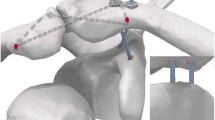Summary
Beside the basic question wether a separation of the acromioclavicular joint should be treated operatively or not, the method of operation is discussed in particular. For that reason we investigated our own method of a temporary transfixation of the joint by a centrally drilled K-wire combined with a PDS-augmentation of the coracoclavicular and a suture of the acromioclavicular ligament. Follow up examinations were possible in 57 out of 82 patients which were operated during 5 years. Patients subjective rating and objective follow up and sonographically evaluated joint conditions were scored together. Looking for the range of motion of the soulder only 5.5 % of the patients had a reduction of more than 20 °. Out of 12 complications in particular three infections only resulted satisfying by influencing the subjective rating negatively. In 28.1 % of patients no durable anatomic reconstruction of the joint was achieved. Score achieved by these patients was significantly lower compared to those with a lasting anatomic reconstruction of the acromioclavicular joint. In conclusion the results confirm our operative regime for separations of the acromioclavicular joint. In literature survey the here described method of operation belongs to the better ones without showing a clear advantage. Nevertheless the method should be modified to decrease the rate of subluxations.
Zusammenfassung
Neben der generellen Frage, ob eine Sprengung des Schultereckgelenks konservativ oder besser operativ behandelt werden sollte, ist es insbesondere die angewendete Operationsmethode, die immer wieder Anlaß zur Diskussion liefert. Dies war der Grund, das eigene Verfahren der temporären Gelenkfixation mit einem zentral geführten Kirschner-Draht in Kombination mit der PDS-Augmentation des Lig. coracoclaviculare und der Naht des Lig. acromioclaviculare zu überprüfen. Von 82 im Zeitraum von 5 Jahren operierten Patienten konnten 64 erreicht werden, von denen sich 57 zu einer Nachuntersuchung bereitfanden. Subjektive Bewertung des Ergebnisses durch den Patienten, objektiver klinischer Untersuchungsbefund und sonographische Beurteilung der Gelenkverhältnisse wurden in einem Punktescore zusammengefaßt. Bei der aktiven Bewegungsprüfung des betroffenen Schultergelenks ergab sich lediglich in 5,5 % der Fälle eine Einschränkung um mehr als 20 °. Von den 12 aufgetretenen Komplikationen waren es insbesondere die 3 Infekte, die das subjektive Urteil der Patienten negativ beeinflußten und so zu einem gerade noch befriedigendem Spätergebnis führten. Bei 28,1 % der Patienten konnte keine dauerhafte anatomische Rekonstruktion erzielt werden. Diese Gruppe hatte einen signifikant schlechteren Punktescore als diejenige mit anatomischen Verhältnissen. Insgesamt bestätigen unsere Ergebnisse das operative Therapiekonzept. Die dargestellte Operationsmethode scheint dabei im Literaturvergleich zwar zu den erfolgreicheren Verfahren zu gehören, zeigt aber keine eindeutige Überlegenheit und sollte möglicherweise modifziert werden, um die hohe Rate an verbleibenden Subluxationen zu verringern.
Similar content being viewed by others
Author information
Authors and Affiliations
Rights and permissions
About this article
Cite this article
Mayr, E., Braun, W., Eber, W. et al. Central K-wire and PDS-Cord for Acromioclavicular separations – a successful treatment?. Unfallchirurg 102, 278–286 (1999). https://doi.org/10.1007/s001130050403
Issue Date:
DOI: https://doi.org/10.1007/s001130050403




